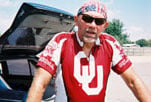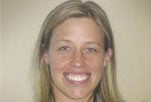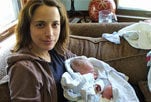My name is Tim Allen and I am 59 years old. I “busted” my foot playing soccer in college and needed surgery to repair it about 35 years ago when I was in the Air Force. However, it got worse recently, and I dislocated my toes whenever I ran. Unfortunately, I developed DVTs in my calf on the same side as the repeat surgery to mend my foot again.
Some of these DVTs moved to my thigh and some moved on to my lungs and heart.
I underwent a CT scan and a massive “saddle” bilateral pulmonary embolism was found. From what I was told by my team of doctors, I was lucky to be alive, probably due to being in better than average cardiovascular shape from swimming 1.5 to 2 miles per day on a regular basis for months before the surgery. The doctor who installed the filter in my renal vein, to block any more clots from traveling to my lungs, said he had never seen a patient survive after such a massive blood clot.
I went home after two weeks on warfarin, and the swelling in my leg from the blood clot went down. I started to research how to get back to running/biking/swimming – how soon, how much, etc.
I returned to my teaching job and felt great for a couple of days. Then, out of nowhere, I felt weak and tired when I got up. I figured it was part of getting back into the swing of things, so I went to school. However, I wasn’t there ten minutes when I began to feel much worse. I felt light-headed, my breathing became rapid and shallow, and I started to feel some pain in my chest. My wife got the school nurse to check me. I was told I was very pale and my BP was 88/60. The nurse told my wife to take me to urgent care, where they checked me and transported me immediately, by ambulance, to the emergency room. I was told that I was exhibiting quite a few of the typical symptoms of a heart attack.
At the hospital, they ran blood enzyme tests which came up negative. There was no heart attack, nor was any recurrence of a pulmonary embolism detected. My cardiologist came in and we talked about what might have caused my symptoms. He thought it was likely due to part of the large blood clot in my lungs breaking away and attaching to another part of the lung. He felt that this might have caused the symptoms as well as the pain I was feeling in my chest.
My doctor had scheduled me for a cardioversion to correct the atrial fibrillation (irregular heart rhythm) that I had for four years. However, since I was already hospitalized, they kept me there to do a special type of echocardiogram to make sure there were no clots in my heart. Since the results of that echocardiogram were clear, they did the cardioversion, which is a controlled electrical current to the heart to reset its pattern to regular rate and rhythm.
I talked with my cardiologist and the team that was going to do these procedures, and they were great. I felt calm and very safe. I had decided that this was one of those things that I had no control over and that my life was in their hands and in God’s, and I trusted them completely. The last thing I remember was the nurse-anesthesiologist telling me that I would be given something to make me dream… I woke up later and found out that there were no sign of clots in my heart. Even though it took two tries to cardiovert or control my atrial fibrillation, my heart returned to a regular rate and rhythm. Before I went in, my pulse ranged between 95 and 102. Afterwards, my pulse dropped to 55 and has stayed as regular as clockwork. I can’t believe how much better I feel.
I got the surgical pins taken out of my toes, and I am able to walk around without crutches, which feels so liberating. I have to wear compression socks, but walking seems to keep the swelling in my leg down. I want to thank everyone who was there for me during this whole experience. The doctors, nurses and staff were wonderful. My doctor took the time to explain everything to me – the problems, the procedures, the prognosis… everything. Since I am a science teacher, information and explanation were what I needed.
I want to channel my energy to do a fundraising ride around Oklahoma next summer to raise money for NBCA, similar to one I did when my wife was ill with breast cancer six years ago. I rode 1800 miles in 17 days to raise some money for research for the Lance Armstrong Foundation. This time I am planning on using a recumbent trike to keep my legs a bit elevated during the ride and help reduce any swelling. I will continue to wear compression socks to keep swelling down and to prevent any complications of DVT as well.
“Twenty years from now you will be more disappointed by the things you didn’t do than by the things you did do. So throw off the bowlines, sail away from the safe harbor. Catch the trade winds in your sails. Explore. Dream. Discover.” — Mark Twain




